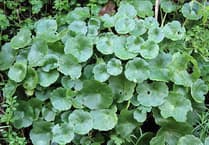Photographer Ray Roberts takes us on this week's Nature Watch walk where there are colourful fungi and insects - and a plant once said to be used to help witches fly.....The common twayblade orchid – Listera ovata – is a very unobtrusive plant as its small flowers, sometimes as many as one hundred on a tall stem, are a yellowish - green and would be very difficult to spot if it wasn’t for the pair of very large oval, leaves at the base of its stem. In fact, it is these leaves that give the plant its name as ‘tway’ is a very old word for two. A large group of twayblades can spread rapidly from a single plant, by means of its rhizomes, on shaded hedgerows and on the edges of woodland.
I went out to photograph the common twayblades at one of the two places I have found them and there they were, hardly noticeable, growing among bluebells and lots of dog’s mercury. Nearby, someone had dumped a large pile of wood chippings and growing on this woody mass where a couple of groups of yellow/orange coloured sulphur tuft mushrooms. These mushrooms grow on dead or discarded timber and can be seen all the year round and are no good for eating but they look lovely when the erupt from the ground.
On what was once a gravelled track were several creeping cinquefoil – Potentilla reptans – with their five petalled yellow flowers. Their creeping roots send up long thin runners that travel across the ground and at each leaf node new fine roots are sent down into the soil. I read somewhere that during the Middle Ages creeping cinquefoil was one of the ingredients in the infamous Witches Ointment, but nevertheless the flowers look beautiful out in the wild or in the garden.
Driving out and back to the orchids site the roadside hedges were covered in large groups of cow parsley – Anthriscus sylvestris. I stopped for a walk around and there were lots of bees and yellow dung flies busy on the white flowers. The yellow dung flies favour alexanders – Smyrnium oleraceum – to feed and mate on if there are no cowpats around, but the yellowish flowers of this plant are now dying off.
I spotted a hoverfly and I could identify it as a Syrphus ribesii which is one of the most common and best known of our hoverflies as they are frequent visitors to gardens and parks as well as hedgerows. Although, to some people these flies look a little like wasps they are completely harmless, in fact their larvae eat as many aphids as they can get hold of, so hoverflies should be welcomed into the garden.
Talking about the garden, we have found several lily beetles on the lily plants recently. These beetles were brought over from Europe and Asia among imported lily plants during the early 1900s, and will eat everything the lily has, flowers, leaves and even bulbs, so unlike the afore mentioned hoverfly. One might think; why, over the last million years, haven’t these scarlet beetles evolved to acquire a green jacket to make themselves less visible on the lilies leaves?




